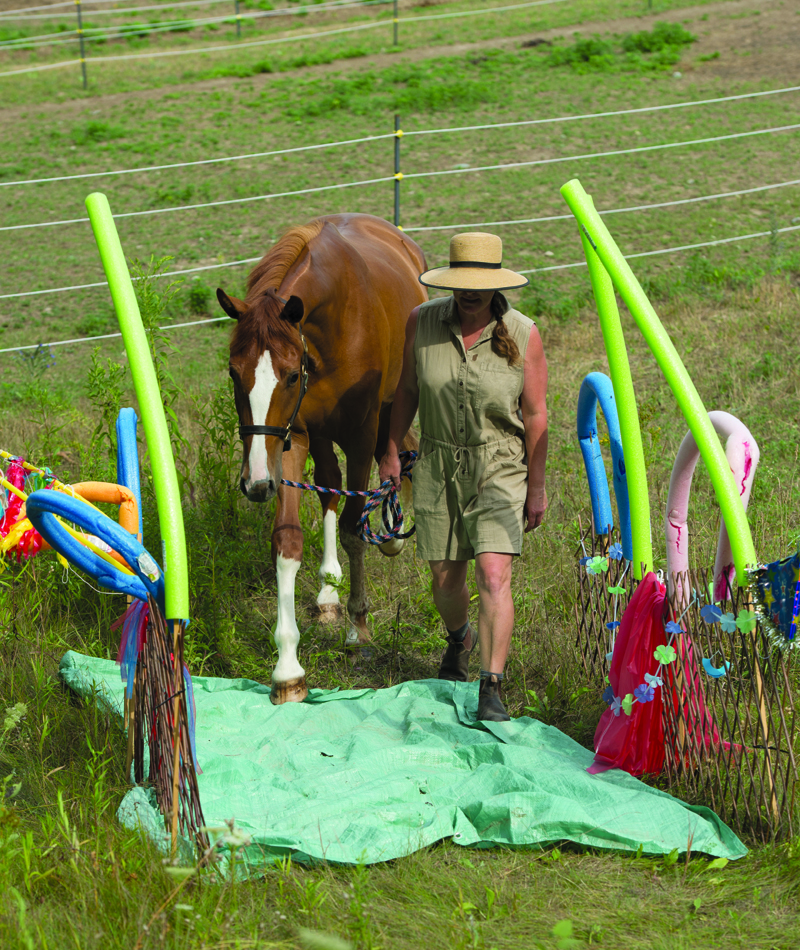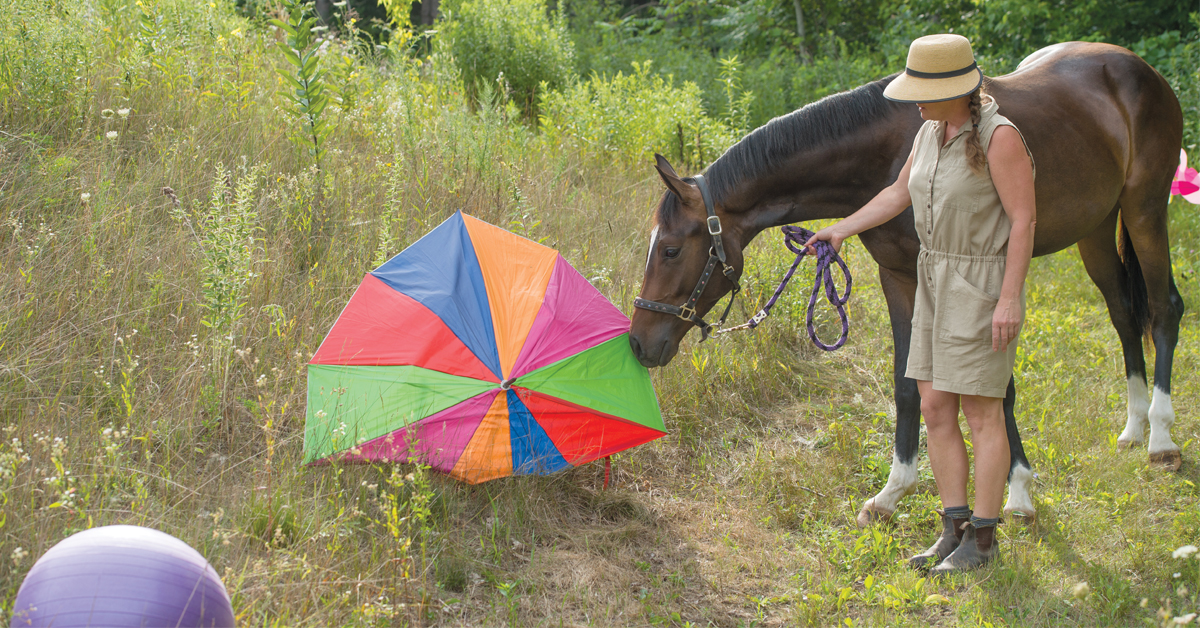After a hiatus from their Hanoverian breeding business, Sally and Garry Moore found themselves missing the young horses around their 100-acre farm in Castleton, Ontario. Taking in a foal for a friend laid the stepping-stone to Fox Hollow Stable’s unique service of not only weaning foals, but also laying a foundation of trust and confidence through gradual exposure to stressful or scary stimuli.
Sally worked at a Hanoverian breeding facility as a young girl, where she fell in love with the breed. In 1994 she and Garry purchased the farm and had their first foal in 2002. The work they did with their own foals earned them a reputation of having well-behaved youngsters. In 2013, they retired from the breeding industry completely. The next spring, as a favour to a friend, they took on a foal she wasn’t quite sure how to raise ‒ and they were hooked once again.
“The foal had become a bit of a nuisance and just needed someone to be calm and confident with the handling,” Sally says. They enjoyed having a little one around so much that they decided instead of running a full breeding establishment they would just work with the youngsters.
Mares are foaled out at their respective facilities, then, as early as one week later, mare and foal arrive at Fox Hollow for the baby’s early development training. Some foals are brought in at six months to be weaned, then stay at the facility to participate in the young horse development program. They accept youngsters up to three years of age to a maximum of eight at one time.
“Our goal is to develop horses that are kind, adore people, and are innately trusting,” says Sally of how young horses in their program are introduced to not only everything a horse might encounter at a horse show, but in everyday life.

Sally leads Stax, a two-year-old who has been in the program since he was a yearling, through a garden path full of whirligigs and balloons. (Clixphoto.ca)
Sally believes that every horse can be confident and relaxed. It is not a complicated process to create well-behaved youngsters; time, patience, a calm manner, and natural progression are keys as is laying a strong foundation. “We spend a lot of time with the foals and young horses,” she explains. “I teach them to become more confident and improve the communication I have with them.”
All of the young horses that come into Fox Hollow are destined for the FEI competition world. Sally believes that to have a good partnership with your horse under saddle you must have sensibility on the ground. In their young horse development program this is achieved through building confidence.
“We want to be able to do anything around the horse without them becoming overly stressed,” Sally says. “We are prepping them to deal with the stress of an international show environment from the stall to the ring. We do this by attempting to decrease stress reactions, tension and spookiness.”

“With controlled exposure to the stimuli, we teach the young horses to respond appropriately and intelligently.”
In training foals, Sally refers to the “yes marker,” a verbal praise which can be combined with a pat or caress. This yes marker is used as a reward every time they are calm around their handler. Once this is achieved, they move onto haltering. “We teach them to lower their head to put on the halter and take halters on and off multiple times per day.”
The next step is teaching them to lead. The foal is walked in front of the dam so they are sure they are following the handler’s lead, not the mare’s. Once they learn to lead, the halt is introduced, with gradually-increasing distractions where they must obtain what Sally calls “four on the floor” – the horse does not lift a hoof, nor does it shift around.
The crossties are introduced for five seconds at a time, then the duration is gradually increased. The next steps are ground-tying, hoof picking, grooming, clipping, and vet prep. Poking them lightly with a toothpick prepares them for vaccinations; applesauce in a syringe prepares them for worming.
From this foundation, everything else is simply a progression of those elements. “We do not progress to the next training level until the foal or young horse is confident. We give tons of rewards [treats and pets] with the “yes” and lots of praise. We do not want to demotivate a young horse. Everything stays calm. Once we have the basics of calmness, haltering, leading, halts, crossties, four on the floor, ground tying, grooming, clipping, trailering, good behaviour for the vet and farrier, we then introduce potentially stressful stimuli. We start in the barn with a recycle bag, rubbing it all over the foal or young horse.”
The Fox Hollow program teaches the youngsters how to respond when they see movement such as garbage bags blowing by, noise from loud speakers, children and crowds screaming. They also introduce them to diverse footing such as tarps, baby pools filled with water or sand, and even empty water bottles. “We teach them how to control themselves in a stressful environment by focusing on preparing their mind, body and spirit.
“We have lots of turnout and socialization for the young horses to develop into well-adjusted citizens. I believe a calm, confident, happy horse will have a lifetime of good health.”
*****
Desensitizing Methods 101
by Horse Sport staff
People have been “desensitizing” horses (attempting to make them non-reactive) for hundreds of years, but many once-common methods are considered outdated these days, knowing what we do about how horses learn. Learning can only occur when the horse is under threshold, which is the point at which the horse changes from noticing a fear inducing stimulus to showing signs of stress or fear. Here are a number of techniques – some of which are effective, and some which need to be shelved permanently.
Counter-Conditioning
This technique attempts to alter a horse’s response to a frightening stimulus until it associates the object/situation with something pleasant (usually treats!). For example, if he is terrified of the clippers, start at a very non-threatening level by feeding his favourite treats as you hold the clippers (not running) in your other hand. Graduate to feeding treats while running the clippers over the horse’s body (still turned off), then turning them on from a distance while feeding treats (obviously a helper will be needed for this step). Through a number of sessions, gradually getting closer to the relaxed horse with the clippers, you should be able to touch him and eventually clip him without a reaction.
Systematic Desensitization
This refers to gradually introducing a frightening stimulus, repeated over time. For instance, an open umbrella could be placed on the ground at a distance; walk your horse towards it but stop while he is below threshold. Let him become bored, then walk forward a few steps again and repeat. This technique can be combined with counter-conditioning (using treats, wither scratches), negative reinforcement (walking away from the object as reward).
Habituation
This is a form of learning in which an animal decreases or ceases its responses to a stimulus (eg. shying at a rock) after repeated or prolonged presentations. Essentially, the horse learns to stop responding to a stimulus which is no longer biologically relevant. For example, horses may habituate to repeated sudden loud noises when they learn these have no consequences. Habituation usually refers to a reduction in innate behaviours, rather than behaviours acquired during conditioning (in which case the process is termed “extinction”).
Approach Conditioning
This method plays on a horse’s natural curiosity. You could have a friend holding an open umbrella move away from the horse, then ask the horse to follow, as long as he remains confident. Gradually decrease the distance between the horse and the offending object until he is willingly approaching it to investigate. Positive reinforcement is handy here; praise or click/reward when the horse is calm, and especially if he willingly follows the object.
Positive Overshadowing
If a horse is faced with a frightening stimulus, the handler can create a more pleasant distraction which gently draws his attention away from the offending object or situation. This could be something you have previously taught such as targeting exercises, or in-hand work such as backing up, or even hand-grazing. The goal is to keep the horse below threshold (showing no fear or anxiety) while engaged in an activity he finds positive while in the presence of the scary thing. This overshadowing can be gradually reduced over time if the overshadowing behaviour is always done well under threshold.
Stimulus Blending
Here the frightening stimulus is applied or introduced in conjunction with a pleasant stimulus (but in a sneaky way) so that the horse tends not to notice the scary thing. For example, your horse loves being groomed but is afraid of fly spray; during an energetic grooming, have someone quietly spritz from a distance, gradually moving closer if there is no reaction. Over several sessions you should be able to apply the spray during the grooming process without fearful behaviour from the horse. There is some risk to this method in that you may well have the opposite effect and the pleasant process becomes “poisoned” by the unpleasant stimulus. In other words, when grooming begins to predict scary fly spray, the horse begins to fear grooming.
Flooding
Once popular among horse trainers, flooding exposes the horse to a stimulus that causes him fear while being restrained or confined from escaping (unlike habituation). The horse is exposed to the fear-inducing object until it no longer responds; for instance, flapping plastic bags may be tied to the saddle and the horse it let loose in a round pen or arena, usually to bolt in terror until he is exhausted and eventually stops running. This lack of hysteria and non-responsiveness does not mean the horse is no longer afraid of plastic bags; it has just given in to a state of learned helplessness.
Suppression/Negative Overshadowing
This correction-based technique is basically using punishment (yelling, whipping, kicking) to either move a horse toward a scary object such as a river, or prevent it from moving away from one such as the flapping bag. Simply put, you are trying to suppress his fear while the overshadowing stimulus – the handler – now becomes the object to be feared. Trainers who feel the need to become the horse’s “leader” are often guilty of using behaviour-suppressing methods.

